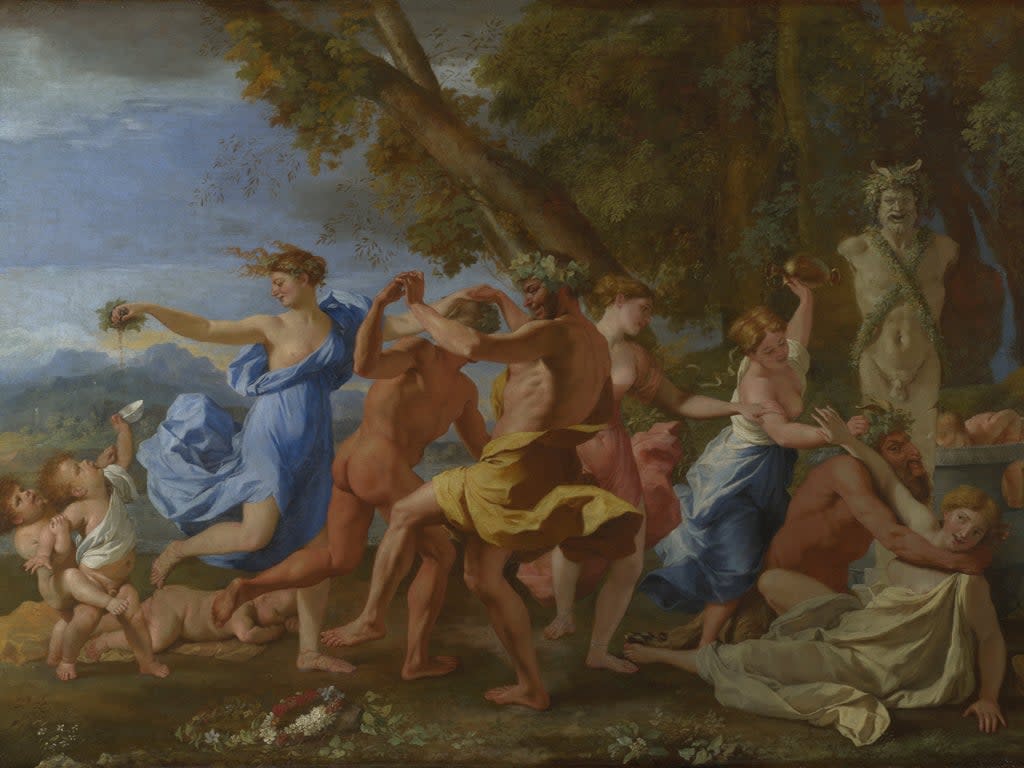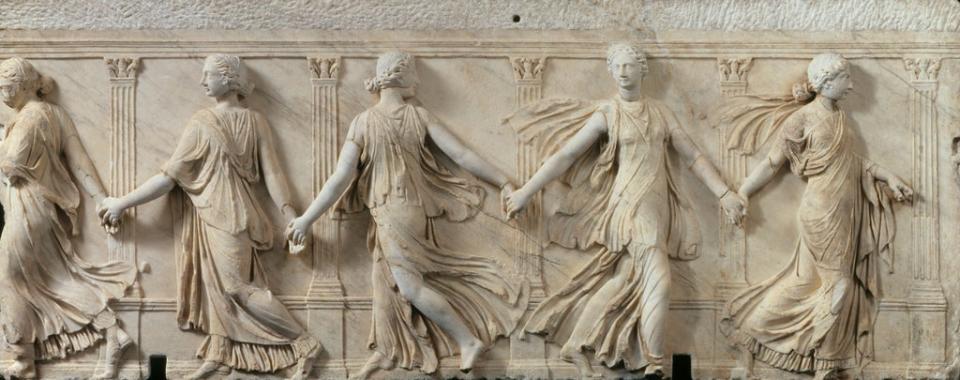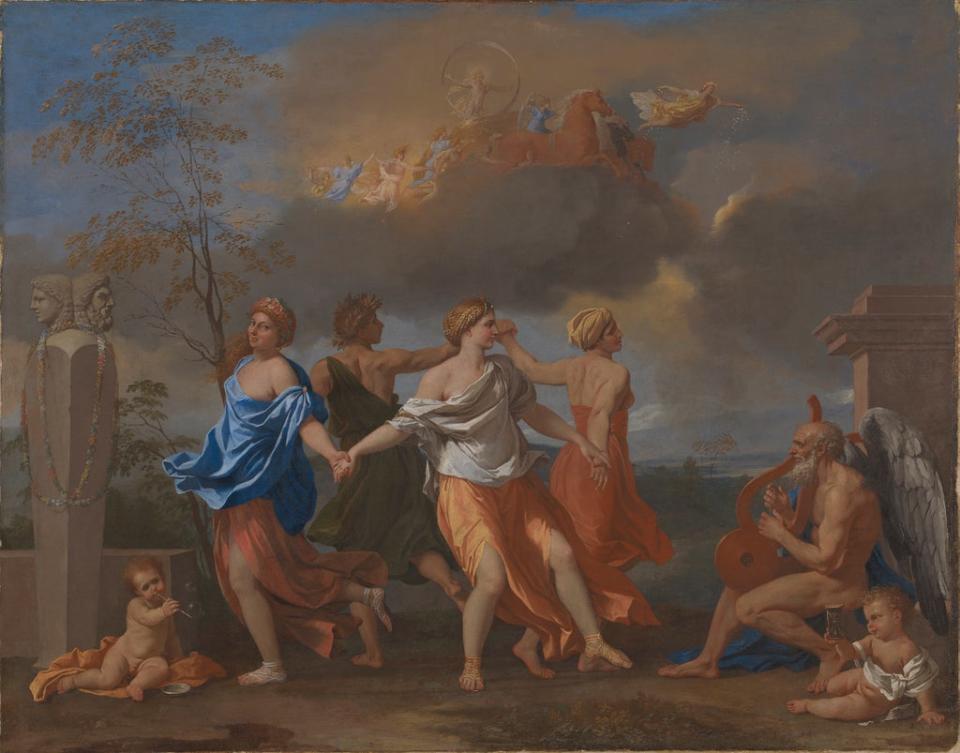Poussin and the Dance review, National Gallery: A youthful, light-hearted look at the French painter

- Oops!Something went wrong.Please try again later.
Drunken nymphs ride goats and fight off the attentions of amorous satyrs as a shepherd gets off with a goat-legged woman. Male and female centaurs belabour a donkey with sticks, while a flute player looks out from a sea of writhing, sun-baked flesh, inviting us to join this orgiastic party in the hills outside Rome. Welcome to the “wild” early work of Nicolas Poussin, the most improbably divisive artist in the entire western canon.
Born in Normandy in 1594, Poussin is certainly one of art’s major names, revered particularly in his native France, though he hadn’t the slightest interest in France or being French. Obsessed from an early age with the art of classical antiquity, he moved to Rome, capital of the Renaissance and the ancient world, at the earliest opportunity, and remained there, apart from a brief sojourn back in France, for the rest of his life. While the practice of painting from life was by this time well established, Poussin maintained a hardcore classicist position in which the sculpture of ancient Greece and Rome represented the only valid standard of truth and beauty.
Far from being written off as an anachronism, Poussin remained one of the dominant figures in western art for a good two centuries, his impressively steely religious and mythological scenes inspiring not only generations of academic painters, but modern masters of the order of Cézanne, Picasso and Francis Bacon. For most of us, though, Poussin’s immaculately ordered paintings have a remoteness that makes them difficult to love. They seem just the kind of grand, worthy old art we know we should be able to appreciate, but tend to hurry past all too quickly when visiting our major galleries. There hasn’t been a major Poussin exhibition in Britain in 20 years.
This exhibition at the National Gallery, however, wants to show us a younger, more light-hearted Poussin, focusing on a 10-year period following his arrival in Rome in 1624, aged 30, when he painted a series of works on what the show calls “the dance”. Drawing on the National’s substantial Poussin collection – the second largest in the world after the Louvre – and beefed up with choice loans, the show argues that before he settled down to a life of serious religious and mythological painting, Poussin sowed his artistic wild oats in images of bawdy bacchanalian revelry, all sozzled nymphs and half-cut satyrs in Arcadian groves.
Poussin’s source for these studies in joyous, uninhibited human movement wasn’t, of course, actual human movement, but classical sculpture, and the show achieves the considerable coup of showing us some of the actual works he drew upon. The Borghese Dancers, a second-century CE marble frieze from the Louvre, embodies the ancient idea of dance expressing the passage of time and the patterns of the seasons and the heavens. The five female figures seem to twist and twirl across the marble slab, their hands linked, billowing drapery that enhances the sense of graceful, rhythmic flow.
The figures carved round a colossal marble jar from Naples invoke a very different conception of dance: getting yourself out of it. Rendered in extraordinarily vivid detail, despite their battered condition, these followers of the wine god Bacchus stand for both the violence of the natural world – a male figure sports a lion skin torn from the living animal – and the drunken ecstasy of ancient pagan rites.
To the 17th-century mind, just about any excess was permissible in art provided it could be justified through the scholarly interpretation of mythology. Poussin’s dance paintings, then, are a kind of post-Renaissance rave art in which the artist, and the cardinals and princes who bought his paintings, were able to let their hair down through transgressional imagery that had been safely validated through high culture.

The earliest paintings here are a touch gauche. Bacchus and Ariadne (1625-6), strongly influenced by Titian, who very much drew on observed reality, has an appealingly rough and ready quality: the paint has degraded over time so the crowd of naked satyrs show as a mass of raw red muscle and thigh against a stormy deep blue sky. Six years on, in The Realm of Flora, he’s moved in a more pedantically classical direction. The figures, all drawn from sculptural models, feel all too obviously conceived in isolation then slotted in around each other, so there’s little sense of human interaction; the faces wear generic and insipid expressions, as though Poussin is more interested in parading his knowledge of mythology than emotionally engaging the viewer.
By A Bacchanalian Revel Before A Term (1622-33), however, Poussin is getting into his limb-swinging, terpsichorean stride. If trying to evoke the spontaneity of human movement from rigid sculpture feels plain perverse, the results here are little short of triumphant. A female dancer finds time to squeeze grapes into a bowl held up by a chubby child, as she and her posse of sun-bronzed satyrs – all clearly plastered – are caught up in a joyous whirl. The scene, like all these dance paintings, is bathed in the evening light of the Campagna, the rugged terrain around Rome, the pathos of the waning sun offset by a hint of thunderous turbulence. It’s an effect that becomes intensely dramatic in The Adoration of the Golden Calf, probably the greatest painting in the exhibition.
The arrangement of the dancers in the previous painting is seen here in reverse, in the figures cavorting around the idol of the Golden Calf, worshipped by the faithless Israelites as Moses fetches the tablets of the law from Mount Sinai. There’s a truly symphonic tension between the joyous figures of the pagan dancers – by whom the pious Poussin should in principle be appalled – and the crowd pointing in wonder from the right, with the white-robed and highly ambivalent figure of Moses’s brother, Aaron, appearing to conduct events from the centre.

The classical device of the “frieze” is taken to absurd extremes in three paintings commissioned by Cardinal Richelieu, the real-life model for the sinister politician in The Three Musketeers, with the middle-foreground of each painting crammed with a mad melee of riotous half-naked figures. Dance here is forsaken in favour of inebriated lurching about, though the facial expressions remain oddly bland. Smiles feel somehow stuck on; a leopardskin-cloaked woman astride a rearing centaur looks weirdly indifferent, as though she’s not bothered whether she’s there or not.
In these paintings, Poussin offers us spectacle rather than real drama. We look on fascinated, amused, possibly mildly horrified, but we don’t come close to identifying with the action. It’s as though to invoke real human emotion would be to risk breaking the mythological spell.
The final painting, and the best-known, A Dance to the Music of Time, on loan from the Wallace Collection, with its four enigmatically smiling figures symbolising the stages of life, makes a fit ending to an absorbing exhibition that left me feeling a lot more excited by Poussin than I’d have imagined possible, and hungry to see a great deal more of his work, particularly his dark and mysterious late landscapes.
For all the National’s attempts to reinvent Poussin as a youthful baroque rebel artist, he remains inscrutable. There is something undeniably difficult and emotionally remote about Poussin’s paintings, an on-the-spectrum awkwardness beneath the superficial elegance, that is at once off-putting and weirdly compelling. It’s precisely this quality that could turn The Father of French Academic Painting into an unlikely artistic hero for our troubled times.
Poussin and the Dance runs at the National Gallery from 9 October until 2 January
Read More
Anish Kapoor: ‘The government is damn dangerous and a bunch of f***ing liars’
Mixing It Up: Painting Today: A big, punchy, entertaining show with an unstoppably upbeat vibe
Books of the month: From Jonathan Franzen’s Crossroads to Sarah Hall’s Burntcoat
Caryl Churchill’s What If If Only explores grief and madness in 17 minutes - review

